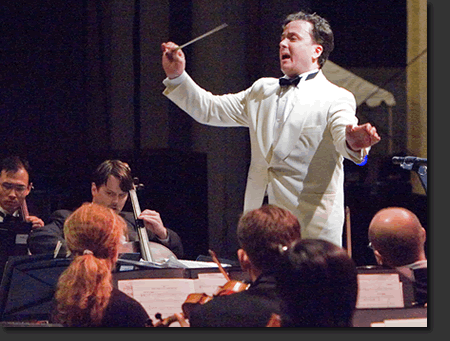Boca Symphonia does well by Beethoven (Mozart and Shostakovich too)
A lifetime of development within a short span of years awaited young Beethoven after the composition of his First Symphony. It’s only natural that he should choose as his model the works of his mentor Haydn, but, even at this early stage, he managed to push the button a little further by making the Menuetto movement into a scherzo.
The Boca Raton Symphonia was an ideal ensemble to present this music Sunday. The size of the ensemble is similar to that of Haydn’s orchestra, and the Roberts Theater at Saint Andrew’s School has an acoustical warmth that is perfectly suited to this early work. Given their usual excellent playing, the clarity of the woodwinds, and the controlled dynamics of the brass, the only thing missing was splitting the violins to the conductor’s left and right. (Bunching them together is a modern concept in which massed sonority is chosen over antiphonal lucidity.) Conductor Alexander Platt made sure that the music charmed, entertained,
uplifted, and astonished as far more than just an early essay on the composer’s journey towards greatness.
Following a ten minute delay, in which the keyboard cover assembly refused to open properly, Mozart’s Piano Concerto No. 21 was able to begin. The Concerto, one of the composer’s most famous, opens with an
initially spare and unharmonized theme. This is subjected to several changes before the winds fill out harmonies and a kind of study in sonority reaches fulfillment.
 Lydia Artymiw proved an ideal soloist, her romantically tinged lyrical approach encompassing a generosity of phrasing, and a full-blooded but Classically controlled expression. There was nothing mannered in her handling of the famous Andante–just pure aria-like melody perfectly suspended with grace over
Lydia Artymiw proved an ideal soloist, her romantically tinged lyrical approach encompassing a generosity of phrasing, and a full-blooded but Classically controlled expression. There was nothing mannered in her handling of the famous Andante–just pure aria-like melody perfectly suspended with grace over
the orchestra’s undulating accompaniment. The lively finale ties everything together in Mozart’s typical rondo fashion and, as usual, the audience rose to its feet in approbation. This time it was well deserved.
The Shostakovich Symphony No. 9 serves as a mostly joyful breath of fresh air wedged between two substantial masterpieces. Composed in 1945, it is a satire on some ugly politics, and not at all the
monumental glorification of Stalin, or mother Russia, that was expected. Its five movements are relatively short, and chock full of sarcastic, nose-thumping, and mock-angst sounds of repression.
Platt chose quick tempos and reveled in the sheer joy of nastiness. If it wasn’t quite as immaculate in execution as it could have been, there was little to quibble about as his solo musicians took their turns in
the spotlight. Concertmaster Misha Vitenson, bassoonist Michael Ellert, and trumpet player Jeffrey Kaye, contributed substantially to the success of this classical bit of buffoonery.
Posted in Performances
Leave a Comment
Mon Mar 23, 2009
at 12:08 pm
No Comments

